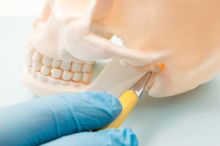
Most people don’t realize it, but the joint that holds your jaw in place is different than the other joints in your body because of its ability to move in multiple ways. In addition to allowing your jaw to open and close, the temporomandibular joint, also referred to as TMJ, can also move side to side and swivel in a circular motion, making it possible to talk and chew easily. Unfortunately, because of the complexity of this joint, it can develop problems. Here is a little more information about temporomandibular joint disorders.
Understanding TMJ Disorders
Symptoms
The symptoms of TMJ are often easy to miss because they can start in a very subtle way. For instance, many people experience pain or tenderness in their jaw area or a slight ache around the ear. However, continued problems with the joint can exacerbate problems, leading to severe facial pain, difficulty chewing, or even a joint that locks spontaneously.
Causes
 TMJ issues have a variety of causes, including physical injury to the jaw area, arthritis, or the tendency to grind or clench your jaw while you sleep. Certain diseases, including autoimmune conditions, arthritis, and cancer, can also spark TMJ issues. People who are exposed to certain environmental factors may also be more likely to develop the condition, and women are more likely to have TMJ problems than men are. In fact, researchers are studying the connection between estrogen levels and TMJ problems in the hopes of making advancements in treatment. Whatever the causes of your discomfort, there is help available.
TMJ issues have a variety of causes, including physical injury to the jaw area, arthritis, or the tendency to grind or clench your jaw while you sleep. Certain diseases, including autoimmune conditions, arthritis, and cancer, can also spark TMJ issues. People who are exposed to certain environmental factors may also be more likely to develop the condition, and women are more likely to have TMJ problems than men are. In fact, researchers are studying the connection between estrogen levels and TMJ problems in the hopes of making advancements in treatment. Whatever the causes of your discomfort, there is help available.
Since TMJ disorders can impact everything from your ability to speak to being able to eat, it’s important to talk with a dentist as soon as you notice problems. At Gladstein Dental Center in New Britain, CT, their experienced dentist can help with everything from jaw pain and TMJ treatments to root canal therapy and dental implants. Learn more about his practice by visiting the website or give his office a call at (860) 223-1162.
About the Business
Have a question? Ask the experts!
Send your question

